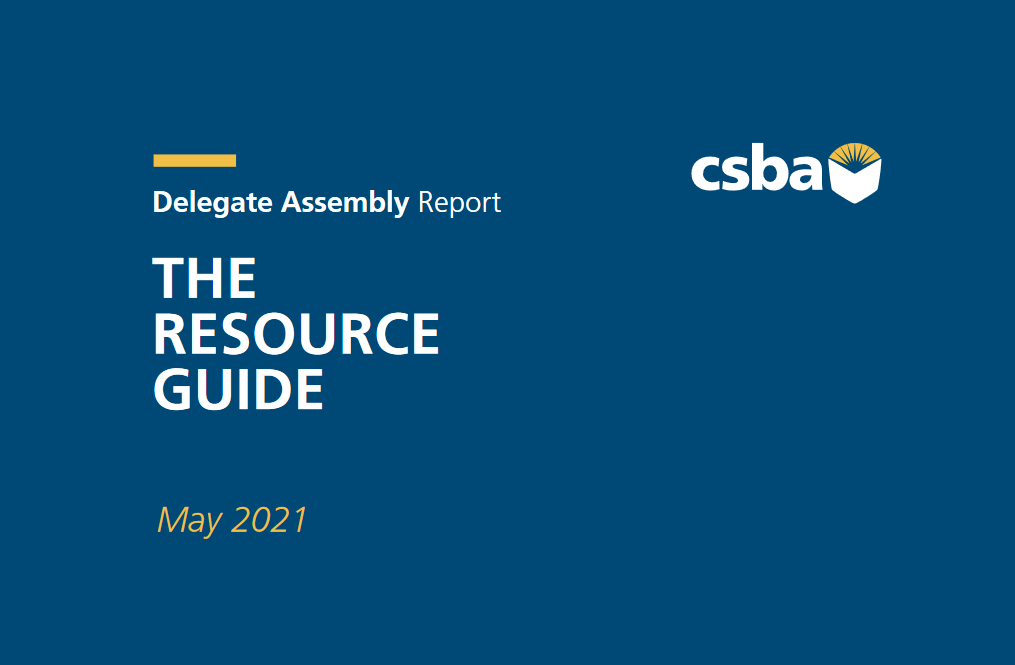By Jeremy Anderson
CSBA’s Delegate Assembly met on May 16, 2021 to discuss one of the most significant and scrutinized issues in the history of California public schools: the return of full-time, in-person instruction statewide. Nearly 250 Delegates were organized into 14 breakout rooms to ask questions, share information, discuss challenges and voice their concerns.
The May 2021 Delegate Assembly Report synthesizes the conversations by the Delegates into seven common topics that local educational agencies are grappling with as they prepare for the 2021–22 academic year.
In conjunction with that report, CSBA also put out a resource guide, “Turning crisis into opportunity: Resources for board members in planning for the 2021–22 year and beyond,” that is meant to give members the tools to address their biggest challenges. Education is at a moment that reflects the title of our report. There is an opportunity to turn the past year’s crisis into a time for revitalization and change towards a better, more equitable future for students. Our resources guide is meant to aid in those goals.
The resources in the guide were put together with ease of use in mind and in direct alignment with the issues that Delegates mentioned.
Ease of use – First, we wanted to ensure that any board member (or school leader) could open the resource and quickly understand how it can be applied to the district’s reopening goals. Each of the resources contains a short description of the content included and why we thought it could be useful. We also wanted to make sure that the resources did not provide members with more unnecessary work. That is to say that we did not want to include large, aggregated lists of resources that were not directly applicable to the challenges at hand.
At the same time, there are some resources that do connect to larger sets of research and/or toolkits for school leaders. For instance, under “Learning Recovery,” Accelerating Student Learning with High-Dosage Tutoring is a guide produced by EdResearch for Recovery that is a part of a larger, combined set of resources from Brown University. The full EdResearch for Recovery guide includes evidence-based briefs that address student learning, school climate, supporting all students, training for teachers and leaders, and strategies for finances and operation.
Direct alignment with local challenges – Before each resource, we broadly discuss a summary of the most current evidence-based research and best practices aligned with the issues. We also include questions that board members and school leaders should consider when addressing the content in the resources guide. These considerations were tailored to help members think about what supports they already have in place, what supports might be most useful for students and staff, and where the resources in the guide might help extend current efforts.
Each of the resources were chosen to align with at least one of the seven most pressing issues Delegates expressed at the May assembly. These challenges include:
- Mental and social-emotional health of students and staff
- Professional development/new hire training
- Selecting professional learning options
- Social-emotional learning and trauma
- Restorative justice and implicit bias training
- Technology
- The use of one-time funds
- Learning recovery
- Assessment
- Summer learning
- Tutoring
- Extended learning programs
- Acceleration
- Supports for students with disabilities
- Supports for English learners
- Program delivery
- Return to campus protocols/health and safety
- Other challenges in fall planning and implementation
- Community engagement
- Targeting resources for English Learners
- A COVID-19 vaccine toolkit
Many of the resources in the guide cover more than one of these central concerns. For instance, the California Children’s Trust’s Practical Guide for Financing Social, Emotional, and Mental Health in Schools contains strategies (including professional development strategies) to help school districts create sustainable mental health supports that last beyond the one-time aid packages from the state and federal government.
We also include a list of relevant CSBA sample policies in each of the seven sections. These policies are available for GAMUT Policy subscribers to use in their local districts.
We hope that this resource guide will help members navigate the extraordinary challenges that school reopening poses. In the same vein, as many districts have already begun the process of reopening, we also hope that these resources will encourage school districts to set up systems of enduring support for students for school years to come.
Jeremy Anderson is an education policy analyst at CSBA.




